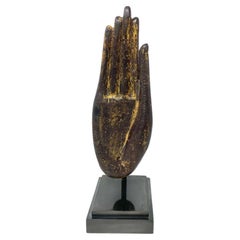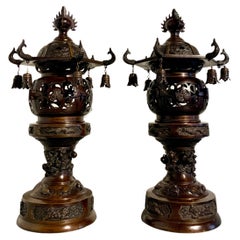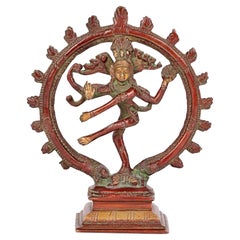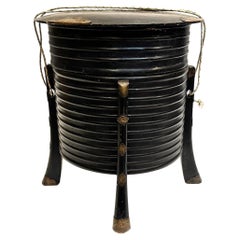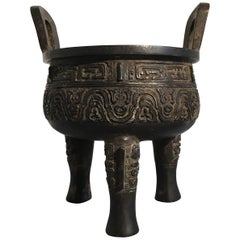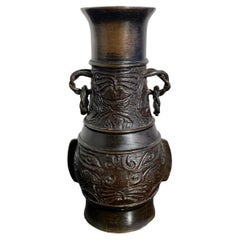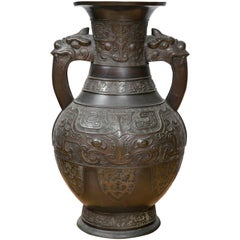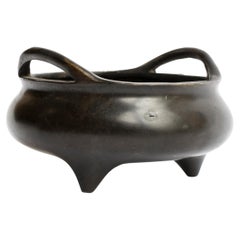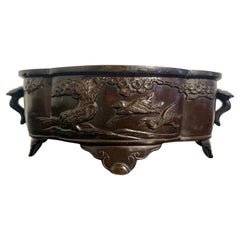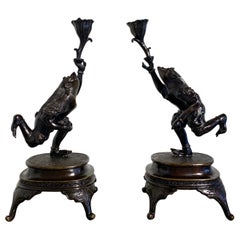Lacquered Metalwork
to
9
1
10
6
4
3
1
9
6
4
3
2
10
8
5
3
1
10
10
10
Technique: Lacquered
Antique Thai Bronze Buddha Hand Fragment, Absence of Fear
Located in Point Richmond, CA
Antique Thai Bronze Hand Fragment, from a life size standing Buddha image in the abhaya mudra, the right hand which is open palm and extended forward in the ...
Category
18th Century Thai Other Antique Lacquered Metalwork
Materials
Bronze
Pair Japanese Bronze Pagoda Temple Lanterns, Taisho Period, circa 1920, Japan
Located in Austin, TX
An elegant pair of Japanese cast and lacquered bronze pagoda lanterns, Taisho Period, circa 1920, Japan.
The lanterns a true pair, with mirrored decorations and lantern doors opening in opposite directions. The lanterns of traditional toro form, cast in bronze, and lacquered. Each lantern comprised of three parts - the "roof", the "fire box", and the pedestal. This type of pedestal lantern is called a dai-doro, as opposed to the hanging lantern type, tsuri-doro.
The hexagonal roof of the lantern, reminiscent of temples or pagodas, features a wonderful, dense cloud pattern with three heart-shaped cutouts, known as inome, or boar's eye. The roof topped by a hoju, the Buddhist flaming Jewel of Wisdom. Each of the six corners feature a fantastic shachihoko, mythical beasts with the face of a tiger and body of a fish. Bells are suspended from the shachihoko.
The globular body of the lantern features four pierced panels with the three leaf hollyhock mon of the Tokugawa clan surrounded by a karakusa pattern of scrolling vines. One panel serving as a hinged door with a lock stylized as the Three Jewels...
Category
1920s Japanese Taisho Vintage Lacquered Metalwork
Materials
Bronze
Indian Asian Lacquered Bronze Dancing Hindu Shiva Nataraja
Located in Bishop's Stortford, Hertfordshire
A fine and unusual vintage Asian Indian red lacquered bronze statue of Shiva Nataraja dating from the 20th century. The figure represents the Hindu God Shiva performing a dance. The ...
Category
20th Century Indian Anglo-Indian Lacquered Metalwork
Materials
Bronze
Japanese Head Bucket (Kubi-Oke), Lacquer, Meiji Period
Located in Point Richmond, CA
Japanese Head Bucket (Kubi-Oke), Lacquer, Meiji period.
The head bucket was used for storing and transporting severed heads. During the Samurai era cla...
Category
Early 20th Century Japanese Meiji Lacquered Metalwork
Materials
Wood, Lacquer
Chinese Archaisit Cast Bronze Ding Tripod Censer, Early 20th Century, China
Located in Austin, TX
A well cast Chinese archaistic bronze tripod censer, ding, in the Ming style, Republic Period, early 20th century, China.
Heavily cast in the arc...
Category
Early 20th Century Chinese Archaistic Lacquered Metalwork
Materials
Bronze
Chinese Bronze Scholar Vase with Taotie, Ming/Qing Dynasty, 17th century, China
Located in Austin, TX
A small and interesting cast bronze archaistic scholar vase with loose ring handles and taotie mask design, late Ming or early Qing Dynasty, mid 17th century, China.
The small vase of archaistic hu form, and cast with archaistic designs. Sitting on a tall splayed ring foot, the round body is cast with a large band featuring a ferocious taotie (ogre) mask. The taotie mask in this case id decidedly feline, with a ruyi shaped snout above a whiskered mouth. Two flanges stick out to either side of the mask, reminiscent of ears.
A wide, tall neck rises from the body, terminating in a slightly everted mouth. The archaistic cast design on the neck is not as clear, but most likely represents Fusang, a mythical island in the Eastern Sea where the legendary Fusang tree grows. The Fusang tree, home to the mythical Sun Bird...
Category
Mid-17th Century Chinese Qing Antique Lacquered Metalwork
Materials
Bronze
Chinese Archaisitc Bronze Small Scholar Vase, 17th Century, China
Located in Austin, TX
A fine small archaistic scholar's vase in the form of a zun, Ming to Qing Dynasty, 17th century, circa 1650, China.
The small vessel of elegant proportions and wonderfully cast. T...
Category
Mid-17th Century Chinese Qing Antique Lacquered Metalwork
Materials
Bronze
18th Century Japanese Silver Inlaid Iron Shogun Stirrup (Abumi) Red Lacquer
Located in Stamford, CT
18th century iron abumi of typical form, the stirrup inlaid in silver, an encircled peony flower crest surrounded with a geometric pattern, the interior retains the original wood lining decorated in red lacquer. The sides and underside also inlaid. Signed by the maker. Edo period.
This is a beautiful example of Japanese metalwork, sublime in it's design and craftsmanship, perhaps once belonging to a Shogun warrior...
Category
Early 18th Century Japanese Edo Antique Lacquered Metalwork
Materials
Silver, Iron
Pair of Japanese Edo Period Iron Silver Inlaid Red Lacquered Stirrups 'Abumi'
Located in New York, NY
A Pair of Japanese Edo Period (1603–1867) iron, silver inlaid, and red lacquered stirrups (Abumi). Each of typical form, made of iron with silver inlay on the front with floral bloss...
Category
1690s Japanese Edo Antique Lacquered Metalwork
Materials
Silver, Iron
Pair of 18th Century Japanese Edo Period Lacquered Samurai Iron Stirups
Located in Dallas, TX
18th century Japanese Edo period Lacquered Samouri Iron stirups with original wooden lacquered insoles. Truly a beautiful pair of Japanese ...
Category
Late 18th Century Japanese Edo Antique Lacquered Metalwork
Materials
Iron
Related Items
Large Chinese Archaistic Black Patina Bronze Altar Vase
Located in Mt Kisco, NY
Chinese bronze vase with decoration in the Archaistic style and dragon mythical beast loop handles.
Category
18th Century Chinese Archaistic Antique Lacquered Metalwork
Materials
Bronze
Chinese Bronze Tripod Censer with Strap Handles, c. 1900
Located in Chicago, IL
For many centuries, people in China have burned incense in shallow censers such as this, placed within a shrine or atop a home altar. An essential element o...
Category
Early 20th Century Chinese Qing Lacquered Metalwork
Materials
Bronze
18th Century Chinese Qing Bronze Duck Incense Burner Sculpture
Located in Haddonfield, NJ
18th century Chinese bronze duck incense burner, Qing period
Please note that one foot is missing, broken off, see detailed image.
Category
Early 18th Century Chinese Qing Antique Lacquered Metalwork
Materials
Bronze
Pair of Cloisonné Bronze Vases, Japan, Circa 1900
Located in Saint-Ouen, FR
Pair of cloisonné bronze vases, Japan, circa 1900, accident on one, slight depression
Measures: H 19cm, D 10cm.
Category
20th Century Japanese Japonisme Lacquered Metalwork
Materials
Bronze
Japanese Silver Incense Burner, Akoda Koro, by Nomura, Meiji Period, Japan
Located in Austin, TX
A lovely and luxurious Japanese silver incense burner of lobed melon form, akoda koro, marked jungin and signed Nomura, Meiji Period, circa 1900, Japan.
The silver koro...
Category
1910s Japanese Meiji Vintage Lacquered Metalwork
Materials
Silver, Sterling Silver
Japanese Cloisonne Box by Inaba, Meiji Period, circa 1900, Japan
Located in Austin, TX
A fine Japanese cloisonne hinged box with pheasant and autumn foliage, by Inaba Nanaho and the Inaba Cloisonne Company, Meiji period, circa 1900, ...
Category
Early 1900s Japanese Meiji Antique Lacquered Metalwork
Materials
Copper, Enamel, Metal
Antique Hindu Bronze Temple Horse and Chariot Statue Toy on Wheels India
Located in North Hollywood, CA
Antique hindu bronze Temple horse and chariot statue toy on wheels.
Commonly known as "Temple Toys," these cast brass figures date back to the early-to-Mid...
Category
Early 20th Century Indian Folk Art Lacquered Metalwork
Materials
Bronze
Japan Fine Antique Bronze Birds & Dragonflies Lantern, Lovely Details
Located in South Burlington, VT
From our recent Japanese acquisitions
Birds and dragonflies
A rare bronze 90 year old lantern find with all hanging bells intact.
This trapezoidal roof shaped hand cast bronze lan...
Category
Mid-20th Century Japanese Taisho Lacquered Metalwork
Materials
Bronze
Large Bronze Dancing Shiva, Nataraja, 19th/20th Century, South India
Located in Austin, TX
A heavy and well cast South Indian bronze figure of Shiva Nataraja, or Shiva as Lord of the Dance, in the Chola style, late 19th or early 20th century, India.
Shiva is portrayed here in his form as Nataraja, the Lord of the Dance. An iconic and powerful image, Shiva is portrayed engaged in his dance of creation, protection, and destruction, bringing together all his aspects into one sublime form.
Shiva dances ecstatically, facing the viewer with his body twisted, his long locks of hair streaming out around him, his four arms in action, with one leg raised, the other stomping on the dwarf demon Apasmara, who represents spiritual ignorance.
In one hand he holds a damaru, or ritual drum...
Category
Early 1900s Indian Antique Lacquered Metalwork
Materials
Bronze
Japanese Iron Pagoda Garden Lantern
Located in New York, NY
Midcentury Japanese cast iron pagoda lantern with lattice fret work hinged door.
Bird and bamboo iron cut outs surround pagoda. Beautiful slo...
Category
Mid-20th Century Japanese Japonisme Lacquered Metalwork
Materials
Iron
Japanese Meiji Period Sterling Silver 2 Handled Basket by Katsu Miyamoto
Located in Dallas, TX
PRESENTING a GORGEOUS, VERY HIGH QUALITY and EXTREMELY RARE piece of Japanese Meiji Period Sterling Silver 2 Handled Basket by Katsu Miyamoto.
EXQUISITE, EXCEPTIONAL, RARE & IMPORTANT!
This is definitely a Meiji Period piece due to the fact that it is marked with the sterling silver mark “jungin”.
The Meiji period was from 1868 to 1912 and in 1928 a law was introduced in Japan compelling the use of decimal marks for silver.
This pre-dates that decimalization law.
We are of the opinion that it is from circa 1900.
Miyamoto Shoko was founded in 1880 as the first silverware specialty shop. In 1899, Miyamoto Shoko’s silverwares were ordered by the family members of the Emperor of Japan, and to this day, they are making fine and graceful handicrafts with skillful craftsmen.
Loved by numerous customers since the Meiji era, Miyamoto Shoko’s products have also been given to Princess Mako and Princess Kako of Akishino, as well as Princess Aiko Toshinomiya, on their birthdays.
Katsu Miyamoto (宮本勝), in 1880, in order to increase the sales of tobacco and cigarettes to foreigners founded the Moyamoto Shoko company, which produced different silverwares in general and particularly silver cigarette cases. Miyamoto’s first name, Katsu (勝) in some sources is written as “Masaru”, since 勝 kanji can be pronounced in both ways.
This basket is of the HIGHEST QUALITY imaginable!
The top of the basket has the MOST GORGEOUS repousse work of flowers, probably lotus flowers, with leaves and foliage. It has an underlying chevron effect chasing, reflecting parquetry.
The 2 handles are cast in the form of bamboo handles.
The rim of the top likewise is cast as bamboo.
The base is equally stunning in a different way!
It is chased with a chevron effect, like parquetry flooring and the four feet simulate pieces of sliced bamboo with an interlinking gallery of support columns, likewise, simulating bamboo.
The QUALITY of WORKMANSHIP is OUTSTANDING!
The pieces weighs exactly 525 grams.
This piece takes my breath away!
This is one for the SERIOUS COLLECTOR of EXQUISITE AND RARE Japanese silver. You will not find another like it, for sale ANYWHERE ELSE IN THE WORLD …… I know as I have searched!
Provenance: Acquired from a Dallas Private Collector.
Dimensions: 9.6 inches wide, 7.6 inches deep and 2.75 inches tall ( 7.25 inches tall with handles up)
Condition: Very good. It looks like the base 4 legged gallery, has been repaired/re-attached to the base, but otherwise it is excellent and of Museum quality.
The Meiji period (明治時代 Meiji-jidai?), also known as the Meiji era, is a Japanese era which extended from October 23, 1868 through July 30, 1912.[1] This period represents the first half of the Empire of Japan during which Japanese society moved from being an isolated feudal society to its modern form. Fundamental changes affected its social structure, internal politics, economy, military, and foreign relations. The period corresponded with the reign of Emperor Meiji after 1868, and lasted until his death in 1912. It was succeeded by the Taishō period upon the accession of Emperor Taishō to the throne.
Solid silver pieces...
Category
Early 20th Century Japanese Meiji Lacquered Metalwork
Materials
Sterling Silver
Small Tibetan Seated Buddha from Bronze, c. 1850
Located in Jimbaran, Bali
A wonderful Tibetan bronze seated buddha on a lotus pedestal from the 19th century. This buddha features a lovely age related patina as well as rich detailing.
Category
19th Century Tibetan Other Antique Lacquered Metalwork
Materials
Bronze
Previously Available Items
Japanese Cast Bronze Suiban Ikebana Vessel, Meiji Period, Japan
Located in Austin, TX
A lovely small Japanese cast bronze suiban, shallow vessel for ikebana flower arranging, signed Takashima, Meiji Period, circa 1900, Japan.
The small Japanese bronze suiban of lob...
Category
Early 1900s Japanese Meiji Antique Lacquered Metalwork
Materials
Bronze
Pair Japanese Bronze Frog Warrior Candlesticks, Meiji Period, circa 1900, Japan
Located in Austin, TX
A fantastic and fabulous pair of Japanese cast bronze candlesticks in the form of armored frog warriors, Meiji Period, circa 1900, Japan.
The delightful mirrored pair of bronze ca...
Category
Early 1900s Japanese Meiji Antique Lacquered Metalwork
Materials
Bronze
H 12.5 in W 6.5 in D 4.5 in
Chinese Archaistic Bronze "Arrow" Vase, Hu, Republic Period, China
Located in Austin, TX
An attractive and well cast Chinese archaistic bronze altar vase, hu, Republic Period (1911 to 1949), early 20th century, circa 1920, China.
...
Category
Early 20th Century Chinese Qing Lacquered Metalwork
Materials
Bronze
Japanese Antique Aluminum Glove Mold 1920s-1940s / Figurine Object Wabi Sabi
Located in Sammu-shi, Chiba
Old Japanese rubber glove mold.
It is made of aluminum.
This item is from the early Showa period (1920s-1940s).
It is very rare.
The texture of used aluminum is beautiful.
I...
Category
1920s Japanese Showa Vintage Lacquered Metalwork
Materials
Aluminum
H 17.13 in W 5.32 in D 4.34 in
Lovely Japanese Bronze Vase with Red Lacquered Peony Flowers
Located in Amsterdam, NL
Elegant baluster-shaped black bronze vase with a red lacquered relief design of blooming peony flowers (botan) and branches with some berries hanging from...
Category
Early 20th Century Japanese Lacquered Metalwork
Materials
Bronze
Japanese Antique Iron Ball "Shell" 1900s-1940s / Figurine Steel Object Wabi Sabi
Located in Sammu-shi, Chiba
It is a very old Japanese rusty iron ball.
It appears to have been a wartime artillery shell.
It is estimated to be a pre-war (1900s-1940s) artillery shell.
It is a very rare item.
...
Category
Mid-20th Century Japanese Showa Lacquered Metalwork
Materials
Iron
H 2.76 in Dm 2.76 in
Japanese Old Iron Rabbit 1940s-1970s / Animal Figurine Object Wabi Sabi
Located in Sammu-shi, Chiba
This is an old Japanese iron rabbit figurine.
It is from 1940s-1970s.
It is made of cast metal.
This type of figurine is rare.
It is very elaborately made...
Category
Late 20th Century Japanese Showa Lacquered Metalwork
Materials
Metal, Iron
H 7.68 in W 3.94 in D 3.15 in
Set of Chinese Enamel Dishes in Lacquered Box
Located in London, GB
Set of Chinese enamel dishes in lacquered box
Chinese, early 20th century
Measures: Central dish: Height 2cm, diameter 37cm
Box: Height 11cm, ...
Category
Early 20th Century Chinese Lacquered Metalwork
Materials
Enamel
Japanese Meiji Bronze Cow Sculpture on Lacquered Stand
Located in Astoria, NY
Japanese Meiji period bronze cast resting cow sculpture, placed on a fine lacquered presentation stand. The piece dates from the Meiji period, circa 1880...
Category
1880s Japanese Meiji Antique Lacquered Metalwork
Materials
Bronze
Chinese Bronze Shizi Opium Weight, circa 1900
Located in Chicago, IL
Whether used to parcel out opium, spices, or other valuable goods, this small figurine was originally used as a counterweight for a tabletop balance. Cast in bronze, the petite weigh...
Category
Early 20th Century Chinese Qing Lacquered Metalwork
Materials
Bronze
Antique Japanese Singing Bowl with Raised Dots
Located in Somis, CA
A beautiful early 20th century Japanese singing bowl, demonstrating rows of neatly arranged raised dots, above which sit sets of perfect bands. I...
Category
Mid-20th Century Japanese Lacquered Metalwork
Materials
Bronze
Antique Japanese Singing Bowl with Raised Dots
Located in Somis, CA
A beautiful early 20th century Japanese singing bowl, demonstrating rows of neatly arranged raised dots, above which sit sets of perfect bands. I...
Category
Mid-20th Century Japanese Lacquered Metalwork
Materials
Bronze
